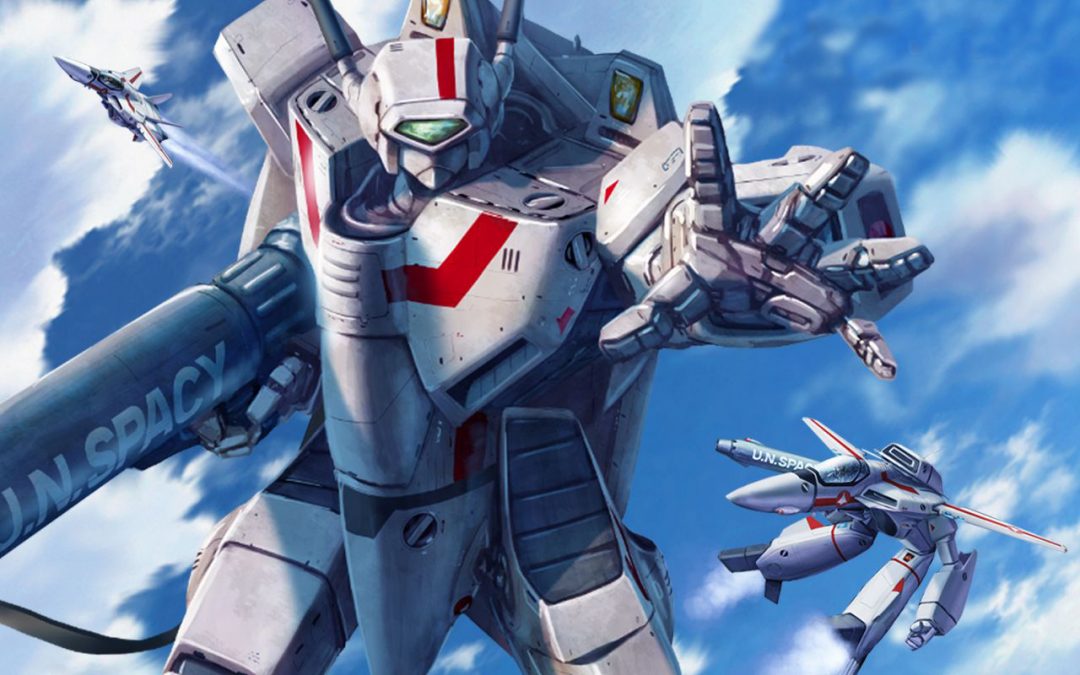The joints are a little creaky now. The fists don’t slip into their hiding place quite as they should these days, and the paint on the nose cone is beginning to peel. All the same, there’s something majestic about my ageing Jetfire toy, which dates back to the height of the Transformers craze in the middle of the 1980s. Whether it’s in its ‘disguise’ as a fighter jet, or transformed into a humanoid robot, or standing hunched over in its unique ‘Gerwalk’ mode, Jetfire has real style and presence. He may be a bit tatty from years of play, but he still feels special; to borrow a phrase from Full Metal Jacket, there are many like it, but this one is mine.
As many geeks steeped in 80s culture know, however, Jetfire didn’t actually begin life as a Transformer at all. Long before American toy company Hasbro brought Jetfire to the west as a heroic Autobot, the mecha was arguably the breakout star of the Japanese animated TV series, Super Dimension Fortress Macross – a 36-episode space opera epic that took in alien giants, daredevil pilots and galaxy-saving pop songs. Animated by Studio Nue, Macross famously emerged in the west as Robotech, a somewhat compromised hybrid of both the original Macross series and two other similarly futuristic anime shows from Japan.
Whether you knew the mecha as Jetfire or by its correct name – the VF-1 Valkyrie – the design was all over the place through the latter part of the 1980s. While Hasbro had purchased the rights to market the toy as Jetfire, the design was also sold off to a variety of model kit manufacturers, including Revell, Hasegawa and Imai. Even if you weren’t into Transformers or Robotech, you’d probably see the Valkyrie in some form if you walked into a toy shop in the 80s. You may even have spotted one of several knock-off Valkyrie toys that emerged from China.
Much has been written about the connection between Jetfire, Robotech and Macross, and the legal battles over who exactly owns the merchandising rights to those designs. But what’s less commonly discussed is why companies have fought tooth and nail for control of Macross and its spectacular mecha: it’s because, we’d argue, the Valkyrie just looks so iconic.
We have designer Shoji Kawamori to thank for the Valkyrie. He was still a student, and barely in his 20s, when he first started working on what would become Macross in 1980. Originally intending to become an industrial designer of vehicles or aircraft, Kawamori instead ploughed his background in mechanical engineering into anime; as his workload increased at Studio Nue – where he designed the spectacular Odyssey ship for the series Ulysses 31, among other things – Kawamori eventually began work on a sci-fi TV show that would eventually become Macross.
By 1980, shows and comics featuring giant robots were already an institution in Japan. Tetsujin 28 and Mazinger Z were hits in the 60s and 70s, while the classic Mobile Suit Gundam, which first appeared in 1979, brought a more plausible, hard sci-fi edge to the fanciful notion of humanoid mecha wading into battle.
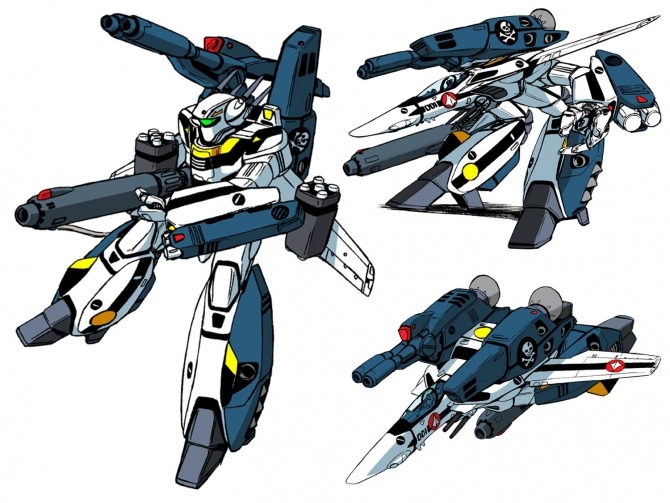
Macross‘s Valkyrie expanded on the idea first floated in Mazinger Z: that of a large mecha piloted by a human, and teamed it with the growing trend for robots capable of transforming into some form of vehicle and back. The Microman Cosmo Countach, released by Takara in 1978, is widely considered to be the first toy that was both a sports car and a (fairly simple) robot. Interestingly, Kawamori was part of the transforming robot zeitgeist himself before Macross; he’s worked on the designs for several toys in Takara’s Diaclone line – some of these were snapped up by Hasbro and given evocative names like Optimus Prime, Ironhide and Starscream. You may have heard of them.
Back at Studio Nue, Kawamori and his collaborators began work on their new sci-fi anime series. They came up with the faintly surreal idea of a colossal robot that could turn into a space-faring battleship – a craft so large that it could contain an entire city with a population of about 50,000. This was the SDF-1 Macross – the mecha of the show’s title, and the fulcrum around which Super Dimension Fortress Macross’ action and drama would turn.
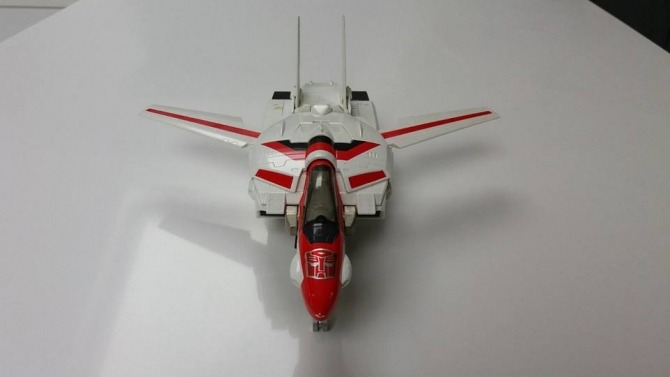
The story went that the SDF-1 was a piece of alien technology that crash landed on Earth and, once repaired by human scientists, provided the rosetta stone for a new form of transforming mech technology. This came in handy when the alien race who originally built the Macross – the Zentraedi – arrive and declare all-out war.
While the SDF-1 got title billing, it was the VF-1 Valkyrie that arguably became Macross’s most captivating mecha. As this Kotaku article points out, Kawamori leaned heavily on the design of a real-world fighter jet for the Valkyrie – the F-14 Tomcat, later famously flown by Tom Cruise in the 1986 movie, Top Gun. Kawamori’s genius, though, was how beautifully he essentially deconstructed the F-14’s design and then figured out a way of turning into a convincing-looking humanoid mecha, which he dubbed its Battroid mode.
Any Transformers fan will recall that some of the lesser toys tended to look better in one mode than the other; Kawamori’s design abilities are such that the VF-1 looks like a functional piece of design in all three forms.
In 2015, Forbes carried a fascinating interview with Kawamori about the process of creating the VF-1, and how it took several iterations before the Valkyrie as we know it really took form.
“At the beginning the arms stretched forward and linked together, so as to form the nose of the plane,” Kawamori said. “However, because of these arms the design looked too fat and didn’t look much like an airplane. So one day I was fiddling with a model of an F-14 Tomcat and noticed that between the two engines was a gap. I thought maybe I could fold the arms in the gap and that ended up becoming the basis for the main design of the VF-1 Valkyrie.”
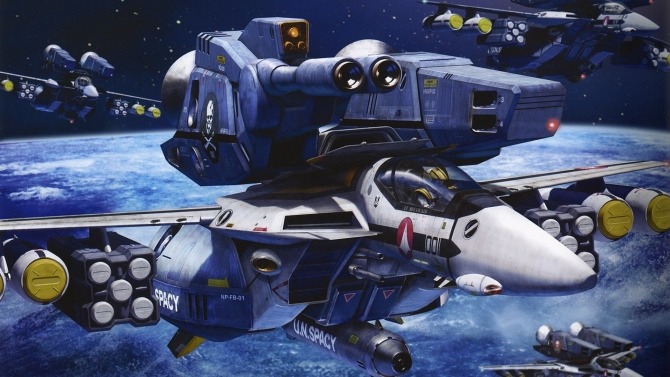
Kawamori’s concept of a third stage, the GERWALK mode (that is, Ground Effective Reinforcement of Winged Armament with Locomotive Knee-joint) actually came about a while before the design of the Valkyrie itself. Kawamori recalls that he was on a skiing holiday when he began to think about a mecha design with its knees bent and its profile hunched forward, just like a skier. As Kawamori worked up the design, he flipped the knee joint around to make it appear more bird-like, and thus the basic idea of the GERWALK mode was born.
Remarkably, the toy company who’d partnered with Studio Nue for Macross, Takatoku, wasn’t initially impressed by Kawamori’s Valkyrie drawings – he recalls that they were convinced that aeroplanes “didn’t sell well”, and that kids simply wouldn’t buy a robot that transformed into a fighter jet.
Given that merchandise was a big part of launching an expensive animated show like Macross, the reaction was a clear blow; cunningly, though, Kawamori had a physical mock-up made of the working Valkyrie toy. It demonstrated two things: one, that not only did it transform cleanly and ingeniously into each of its three modes; and two, it looked incredible sitting on a desk.
“When the toy company saw the prototype,” Kawamori recalled, “they agreed to the design and series plan on the spot.”
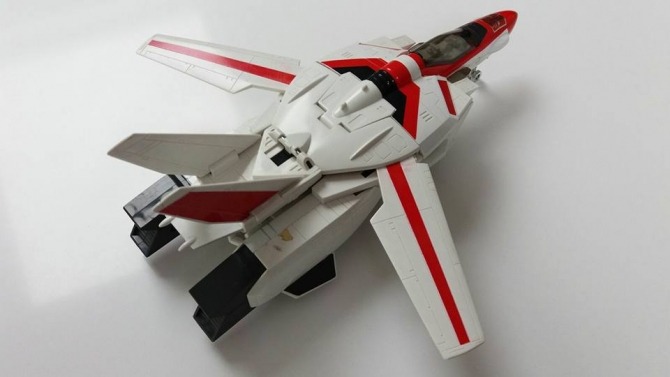
In other words, Macross probably wouldn’t have existed without the Valkyrie. First aired in October 1982, Super Dimensional Fortress Macross was an immediate hit – and, as you’ve probably guessed by now, the Valkyrie toys were a huge coup for Takatoku. The series’ mix of high-tech action and old-fashioned romance proved irresistible to audiences in Japan, while Robotech, syndicated across America from March 1985, was immensely popular in its own right.
Leading to spin-off movies and follow-up shows, Macross has remained a fixture in Japanese pop culture ever since. The latest series, Macross Delta, aired in 2016. Once again, Kawamori worked on its direction and mechanical designs, and once again, it spawned a wave of toys and model kits. (Giant robots are no longer quite as popular among Japan’s otaku as they once were, though, which might explain why Delta’s advertising is more focused on wide-eyed female characters than cool mecha.)
But while Macross has moved with the times, it’s worth noting just how charismatic the original Valkyrie still looks. It may be based partly on a fighter jet originally conceived in the late 60s, but both the Valkyrie and F-14 have a timeless quality; there are some designs that are so beautifully conceived that they simply function as a great-looking piece of industrial sculpture. In its Battroid mode, the VF-1 has an imposing yet athletic silhouette; Kawamori’s design may be pure science fiction, but it somehow manages to look functional – even deadly.
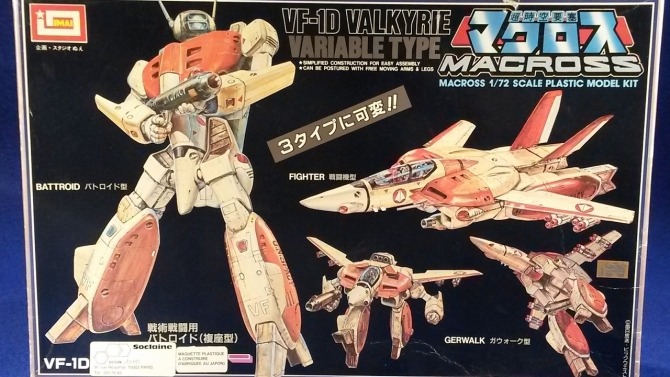
The strength of the Valkyrie’s design is such that, over 35 years after Macross originally aired, toy and model kit manufacturers are still bringing out merchandise based on it. Later this year, Bandai is bringing out a new, larger-scale edition of the Valkyrie toy – it’s the VF-1J, the same model first piloted by hero Hikaru Ichijo back in 1982. It’s slightly taller than the Valkyrie toy that would become Jetfire in the mid-80s, and with a price of about $175, it certainly isn’t cheap.
Bandai’s new, deluxe Valkyrie may be a bit rich for my blood, but Kawamori’s mecha looks pretty remarkable in all its forms, whether they’re model kits, toys or 2D drawings. Even a battered Valkyrie, missing its decals, its joints so stiff and fragile that I’m afraid to even transform it too often, has a quiet dignity about it – like an ageing samurai gritting its teeth, preparing for one last battle.
This is my Valkyrie; there are many like it, but this one is mine.

